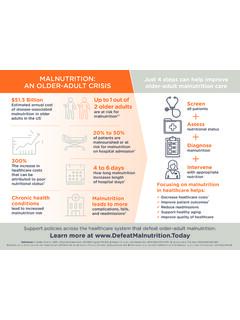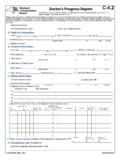Transcription of Malnutrition And Older Adults: Review Of The U.S. Federal ...
1 Malnutrition AND Older . adults : Review OF THE Federal health POLICY. LANDSCAPE. Defeat Malnutrition Today January 2017. ABSTRACT. Malnutrition is a serious epidemic facing Older Americans. Despite the prevalence and seriousness of Malnutrition , the term Malnutrition is not mentioned in enacted or proposed legislation. While Congress has called attention to the importance of the nutritional habits of Older adults , the issue of identifying Malnutrition as a specific indicator of health has not been acknowledged. An environmental scan identified several legislative and regulatory comments and reports that have called for action. Malnutrition is a serious public health issue for Older Americans and needs to be addressed through policy to ensure an integrated, sustainable Figure 1: Malnutrition Screening and approach to promoting better health outcomes. Assessment Tools With strong, consistent attention to the issue, the There have been limitations in clinical settings health challenges associated with Malnutrition in to adequately identify and describe the extent Older adults can be addressed in a preventative and degree of Malnutrition in Older adults .
2 And effective way. While there are screening and assessment tools currently available, these are not routinely used in clinical settings and are not always validated and reliable in different care 1. INTRODUCTION settings. Some potential screening tools to identify and assess Malnutrition in Older Malnutrition is a serious epidemic facing Older adults : Americans. The prevalence of Malnutrition in Mini-nutritional assessment (MNA) tool1. adults 65 years and Older is a growing concern Malnutrition Screening Tool (MST)2. because this health condition often goes Short Nutritional Assessment Questionnaire undiagnosed and unrecognized, resulting in costly (SNAQ)3. and sometimes fatal health outcomes. Upon Malnutrition Universal Screening Tool admission to a hospital, one in three patients is (MUST)4. malnourished and about a third experience Nutritional Risk Screening 2002 (NRS-2002)5. declines in nutritional status during their hospital 1 stay, increasing cost of care by up to 300 Malnutrition , which is related to an excessive or 2 imbalanced diet and/or a diet that lacks essential 20 Tool_FINAL% nutrients, can also be tied to clinical conditions 3 Malnutrition /screening-tools/snaq-tools- in-english/.
3 That impair the body's absorption and/or use of 4 food. While many factors can impact the health 5 and well-being of Older adults , Malnutrition is a condition that is linked to increased incidences of falls, hospital admissions and readmissions, chronic disease, co-morbid health conditions, and psychological Yet, Malnutrition can be identified (Figure 1) and practical, cost-effective solutions to Malnutrition are available. Of particular concern is protein Malnutrition . Age, physical trauma, prolonged bed rest, and the stress of disease, infection, or injury can all increase loss of the body's muscle and protein stores and further increase the risk for Malnutrition . Malnutrition takes a physical toll on individuals and families and it can Page | 1. also have a serious financial impact. The costs associated with Malnutrition can be significant: The annual burden of disease associated Malnutrition in adults 65 years or Older is estimated to be $ billion. 3 As the population of Older adults 65 continues to grow, the incidence and cost of Malnutrition will continue to rise.
4 Practical, cost-effective solutions to Malnutrition are available (Figure 2). When not properly addressed, Malnutrition can lead to further deterioration of functional abilities, thus making it harder for Older adults to recover as well as leading to earlier mortality than if the nutritional risk was Due to biological and physiological changes in function in Older adults ,5. comprehensive nutritional services that address the multiple layers of Malnutrition should be incorporated into existing healthcare services . Importantly, Malnutrition may be related to health disparities as well. A 2011 report from the Agency for Healthcare Research and Quality documented that Older African Americans have a significantly higher risk of Malnutrition (defined as unintentional weight loss) when compared to On July 30, 2015, the National Black Nurses Association (NBNA) released a resolution on nutrition as a vital sign, concluding that Older African Americans have increased rates of chronic diseases in America and because chronic disease is often Figure 2: Malnutrition Interventions associated with Malnutrition , NBNA therefore resolved to support the need for direct, Effective interventions to address Malnutrition can include: culturally competent nursing involvement across the Identifying and treating any underlying disease or other cause continuum of healthcare in the systematic Malnutrition Referring to a registered dietitian nutritionist for an assessment screening and interventions for and care plan Older adults .
5 7. Connecting with social and community supports, including meal Given the importance of delivery and government food programs Malnutrition for Older adult Using oral nutrition supplements particularly those high in health , this Review investigates protein--to help rebuild muscle and strength the Federal health policy landscape related to Malnutrition and Older adults , considering how, if at all, the issue is addressed in existing legislation and is reflected in legislative and regulatory comments and reports. The Review concludes with a discussion of potential policy actions and recommendations. 2. Federal LEGISLATION. Despite the prevalence and seriousness of Malnutrition , the term Malnutrition is not mentioned in enacted or proposed legislation, especially in reference to Older adults and their wellness. Addressing the nutritional needs of Older adults is not a new phenomenon in Congress. Yet, while Page | 2. Congress has called attention to the importance of the nutritional habits of Older adults , the issue of identifying Malnutrition as a specific indicator of health has not been acknowledged.
6 Many proposed acts, such as 2404, the Treat and Reduce Obesity Act of 29158 and 1686, the Preventing Diabetes in Medicare Act of 2015,9 address the need to include nutrition counseling and education into public services . However in current legislation there are no specific mentions of increasing Malnutrition screening and intervention. Some laws address nutritional needs of Older adults and could be amended to include Malnutrition care. The Older Americans Act Existing nutrition services for Older adults are funded and authorized through the Older Americans Act, and because funding has not kept pace with the growth in the Older adult population, there have been significant cuts in program services nationwide. The lack of the Older Americans Act's specificity around identifying Malnutrition as a serious indicator of health should be addressed, given Malnutrition 's connection to increased incidence of chronic disease, hospital costs, health complications and mortality. Title III-C of the Older Americans Act provides state funding for congregate and home-delivered meals, nutrition screening, education and counseling, and an array of other supportive and health services .
7 However, it does not include specific, validated measures to screen and intervene for Malnutrition in Older adults , including those in clinical settings. Medicare Eighty-two percent of Medicare recipients are Older adults ,10 and this legislation, through the Social Security Act, addresses the importance of incorporating nutrition screening into healthcare practices. Yet Malnutrition as a specific indicator of health is not mentioned in any legislation related to Medicare coverage. Medicare Part B covers preventive screenings and interventions, such as medical nutrition therapy (MNT), which includes an initial nutrition and lifestyle assessment, one-on-one nutritional counseling, and follow-up visits to check on diet However, MNT coverage is limited to only those individuals who have diabetes or kidney disease or have had a kidney transplant in the last 36 months. Obesity screening and counseling is also included in Medicare coverage, but not Malnutrition screening or While obesity is more often recognized as an indicator of poor health , Malnutrition can still be present, specifically individuals can be overweight or obese but protein deficient and thus at greater risk of medical complications and prolonged recovery.
8 The Affordable Care Act The Patient Protection and Affordable Care Act13 is comprehensive in listing public health initiatives to address nutrition and wellness (diet, exercise, well-being, etc.), but these initiatives do not address the health indicator of Malnutrition in any specific sense. Nutrition is mentioned broadly under personalized health advice and counseling services . Nutrition counseling is also mentioned throughout in terms of Page | 3. wellness. But there are no allowances for Malnutrition screening or coverage. In SEC. 4103 Medicare screenings are increased through the Affordable Care Act including in the annual wellness visit, preventive screenings (diabetes and certain cancers)14 but Malnutrition is not specifically addressed. 3. Federal POLICY LANDSCAPE: KEY FINDINGS. While attention to Malnutrition in Older adults has not been specifically legislated or regulated, an environmental scan identified several legislative and regulatory comments and reports that have called for action.
9 Since 2009, the American Society for Parenteral and Enteral Nutrition ( ) has hosted Malnutrition Awareness Week to raise awareness about the importance of assessing and intervening earlier in healthcare settings to address Malnutrition . As a result, several Members of Congress have mentioned Malnutrition in their remarks in the Congressional Record. Some statements recognize the incidence and impact of Malnutrition while others have even recommended standardized Malnutrition screening, assessment and intervention for Older adults . The following representatives submitted statements in 2015: Rep. Marcia L. Fudge (D-Ohio) (September 29, 2015)15. Rep. Joyce Beatty (D-Ohio) (September 29, 2015) 16. Rep. Renee Ellmers (R-NC) (September 30, 2015) 17. Rep. Norma J. Torres (D-CA) (September 29, 2015) 18. Rep. Michelle Lujan Grisham (D-NM) (October 1, 2015) 19. In 2016 in the Senate, Sen. Bernie Sanders (I-VT) addressed Malnutrition as a serious public health concern by adding his remarks to the Congressional Record regarding the reauthorization of the Older Americans Act, citing nutrition as an important component supported by the Act's services : Providing home-delivered meals Meals on Wheels for seniors is not only the right thing to do, it makes good economic sense.
10 Why is that? If frail seniors do not get the nutrition they need, they are more likely to fall and break a hip and wind up in the hospital emergency room or in a nursing home. At the end of the day, investing in nutrition which keeps seniors healthy actually saves us money by keeping them out of the hospital. 20. On July 15, 2014, the United States Senate Committee on Finance held a hearing entitled, Chronic Illness: Addressing Patients' Unmet Needs, which acknowledged that nutrition is an important contributing factor to the health , well-being and costs of chronically-ill individuals, although Malnutrition was not explicitly mentioned21. At the 2015 White House Conference on Aging (WHCOA), Department of Agriculture Secretary Tom Vilsack announced a new proposed rule to increase accessibility to critical nutrition for homebound, Older Americans and people with disabilities by enabling the Supplemental Nutrition Assistance Program (SNAP) benefits to be used for services that purchase and deliver food to these households.



